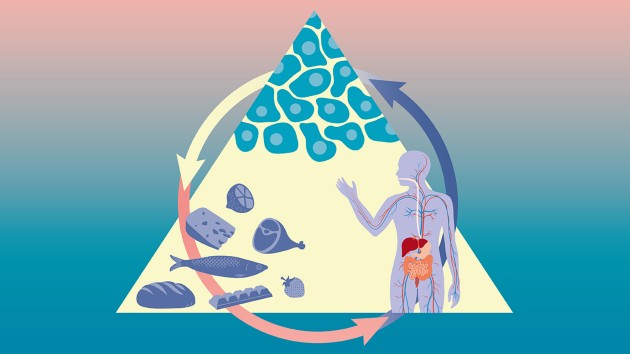Collections
Filters
-
Collection Type
-
-
Series |
 Sex differences in cancer
Sex differences in cancer
Sex differences begin at fertilization and affect nearly all body systems during development.
Image: Lara Crow/Springer Nature Limited -
Series |
 Diet and systemic metabolism
Diet and systemic metabolism
This series of articles explores how changes in diet and systemic metabolism can influence tumour development and progression, how this is affected by the presence of metabolic disease and how we can use this knowledge to improve anticancer therapy.
Image: Lara Crow/ Springer Nature Limited -
Series |
 Cancer origins
Cancer origins
A clearer understanding of the biological underpinnings of cancer origins might help us design more effective cancer prevention methods or improve early detection of tumours that are likely to become malignant. Furthermore, delineating the cell of origin of a specific tumour and the evolutionary changes that underlie its development should also improve our ability to effectively treat that tumour. All of these goals will be aided by increased knowledge of the early pre-neoplastic changes in cells that have the capacity to become tumorigenic, determining the cells of origin of different cancer types, and understanding the interactions of pre-neoplastic or tumour cells with each other as well as with the supporting microenvironment. This series of articles takes a look at recent progress in the diverse fields that have provided insights into this intriguing problem in cancer biology.
-
Series |
 Clinical insights
Clinical insights
Clinical studies can teach us a great deal about the processes and mechanisms underlying cancer, and they also remind us of aspects of cancer that we still do not understand. For example, why patients with metastatic special neuroblastoma undergo spontaneous tumour regression; why some rare types of cancer are metaplastic; and why some patients are exceptional responders to chemotherapy. In recognition of these types of informative findings from the clinic that are often overlooked by laboratory-based cancer researchers, we have commissioned a series of Clinical insights Comment articles. Thinking more broadly about these more unusual aspects of cancer might help us overcome some of the current stumbling blocks in cancer research.
-
Series |
The next 10 years
Cancer research has diversified as our understanding of the complexity of this disease has expanded. Thus, it is difficult to cover in one article where progress is likely to come in the next 10 years based on what we have learnt recently. To address this, we have commissioned a special series of articles that focus either on the hottest areas currently in cancer research, such as epigenetics, heterogeneity and metastasis, or on forward looking concepts that may or may not result in new treatments for cancer patients. We hope that all of these articles will serve as food for thought on the future of cancer research.
-
Series |
Genomic instability in cancer
Genomic instability is often associated with cancer and can be indicative of a poor prognosis for some types of cancer. But, is genomic instability a consequence of tumour progression or an active process that drives tumour evolution? The answer to this question has still not been entirely resolved. Many new findings have highlighted certain DNA repair pathways and cell cycle control processes that have important consequences for genomic stability and tumour cell biology. Indeed, there are numerous efforts to manipulate the DNA damage responses to selectively induce tumour cell death through catastrophic genomic instability, and some are already showing promise. Of course, radiotherapy and other existing chemotherapeutic agents should not be overlooked as therapeutic strategies by which DNA damage induces tumour cell death and there are various efforts to improve the response to radiotherapy and to understand responses (and resistance) to current cytotoxic chemotherapeutics. This series takes a look at the progress made in this field and the questions that remain about the role of genomic instability in cancer.
-
Series |
Models of cancer
Models of cancer come in a variety of forms, from cancer cell lines in culture to genetically modified mice. In between are a host of organisms that also contribute to our understanding of this disease. Yeast, for example, have added much to our knowledge of the cell cycle and the maintenance of cell polarity, whereas egg extracts from Xenopus laevishave helped our comprehension of biochemical pathways and protein modifications essential for normal cellular function. Work onCaenorhabditis eleganswas crucial for our grasp of the genetic pathway that regulates programmed cell death, and research in Drosophila melanogaster has identified several pathways that are deregulated during cancer formation, including the Hippo tumour suppressor pathway. Whether results are generated by cell lines, yeast, mouse orthotopic tumour models or zebrafish the cumulative information from these models should help us to understand in greater detail the subtleties of cancer formation.
-
Series |
Epigenetics and genetics
The deregulated expression of genes and non–protein coding RNAs, which occur through both genetic mechanisms (such as mutation and translocation) and epigenetic mechanisms (such as promoter methylation and histone modifications) are known to promote tumorigenesis and tumour progression. Our knowledge of the mechanisms through which such changes occur and the resulting effects on tumour biology and clinical outcome is increasing rapidly. This series of articles highlights this recent progress and discusses the implications for cancer diagnosis and treatment.
-
Series |
Therapeutic resistance
Beginning in the July 2009 issue, Nature Reviews Cancerwill be publishing a series of articles that take a look at different aspects of therapeutic resistance. Resistance to therapy — chemotherapy or radiotherapy — is an increasing problem in the care of patients with cancer. Numerous culprits have been identified, including environmental adaptations to therapy, aberrant regulation of drug transporters and signalling feedback loops that bypass targeted therapies. As discussed in the articles in this series, multi–targeted drugs, improved understanding of feedback regulation, pathway crosstalk and resistance mechanisms, as well as predictors of response all aim to overcome this significant challenge.
-
Series |
RB and E2F
Although not cloned in 1971, the RBtumour suppressor gene is famous for being the subject of the Knudson two hit hypothesis. Much has been discovered about RB since then, but how it functions as an tumour suppressor remains enigmatic. Aside from its regulation of the G1 phase of the cell cycle, in particular by suppressing the function of the E2F family of transcription factors, there is increasing evidence that RB regulates other important cellular pathways. Indeed, it is now No. longer possible to cover the potential functions of RB and E2F in one bite-size review. Instead, we have commissioned a short series of articles that discuss some of newer strings that have been assigned to the RB bow and some of the questions that still need to be answered.
-
Series |
Senescence
Senescence and its potential contribution to cancer has often been overlooked, perhaps because it is easier to assess, both in vitro and in vivo, the net contribution of cell loss through death rather than permanent cell cycle arrest. However, many recent discoveries, aided in part by the availability of established markers of senescent cells in vivo, have rekindled interest in senescence as a tumour suppressive mechanism. This series of articles on senescence highlights the latest progress, and whether our increasing understanding of the mechanisms that trigger senescence might be useful for the development of innovative cancer therapies that enable patients to live long term with stable disease.

 Classical oncogenes and tumour suppressors
Classical oncogenes and tumour suppressors